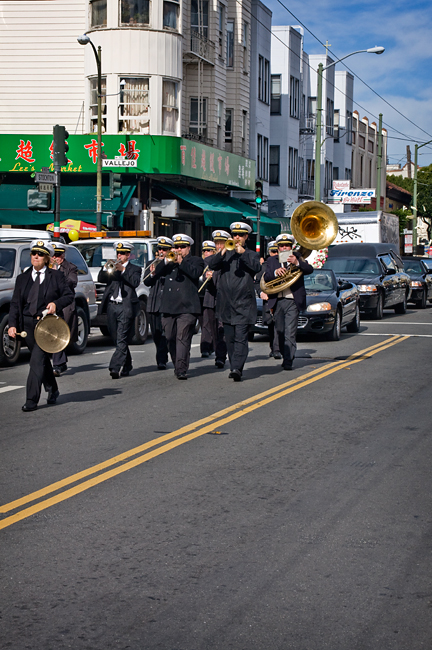F I R S T P R E V
P R E V 946
946 NEXT
NEXT LAST
LAST


Funeral Procession, North Beach
It is a common sight in North Beach and Chinatown to see a funeral procession led by the Green Street Mortuary Band and followed by the mourners in their cars. The lead vehicle, a black convertible, always displays a huge portrait of the deceased propped up on the seat back for all to see.
This tradition of displaying the departed leads us to consider the story of the legendary bandit Joaquin Murieta, the Robin Hood of El Dorado. Like all legends the facts of Murieta's story are unclear, from the spelling of his name to the place of his birth. I will go with the account by early 1900s historian Herbert Asbury.
In 1849 the 17-year old Joaquin Murieta and his wife Rosita arrived in San Francisco from Mexico and soon staked a rich gold claim in Stanislaus County. White miners, angered by his quick success stole his claim, raped his wife, killed Murieta's brother, then viciously beat and left Joaquin for dead. Over the next three years Murieta engaged in a campaign of vengeance against those who mistreated Mexican and Chilean miners.
Murieta, along with a band of men, plundered stagecoaches, raided mining camps, killed those who had attacked him, and became known as a bandit king. In reality almost every unsolved crime that took place in the Gold Country was ascribed to Murieta and his band. Their legend grew beyond what one gang could have possibly accomplished. In addition stories of the Murieta's giving money to the poor began to arise.
No matter the real story, in 1853 California legislators posted a $5000 reward for Murieta and Governor Bigler approved the hiring of Captain Harry Love and a posse to hunt down the bandit. After only one month on hunting, Love and his men came upon a group of Mexicans and killed their leader. Despite the fact that none of the men had ever seen him, they declared that they had killed Joaquin Murieta. They cut off the man's head, put it in a bottle of alcohol, and returned to San Francisco with their trophy.
However the newspaper, Alta California pointed out the head did not bear Murieta's well-known facial scar. An number of other people came forward to assert that the head was not that of Murieta including a woman who claimed to be his wife, Rosita. She insisted that he was still at large in the Sierras. Despite this, the bottled head was displayed for decades drawing thousands of the curious. Eventually the head ended up in the San Francisco Museum of Horrors on Market Street until it was lost in the earthquake of 1906. Today Murieta's legend lives on still in stories, songs, poems, and movies.
[
MAP E-15 ]